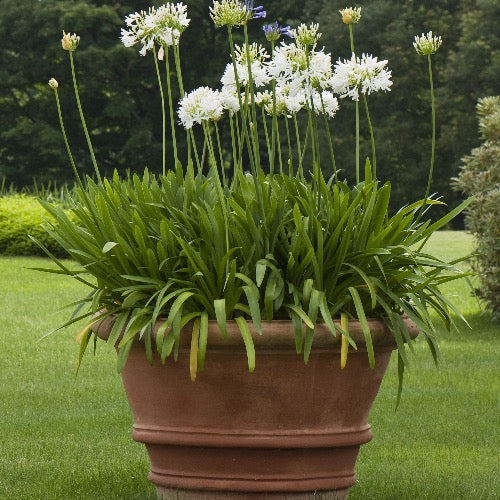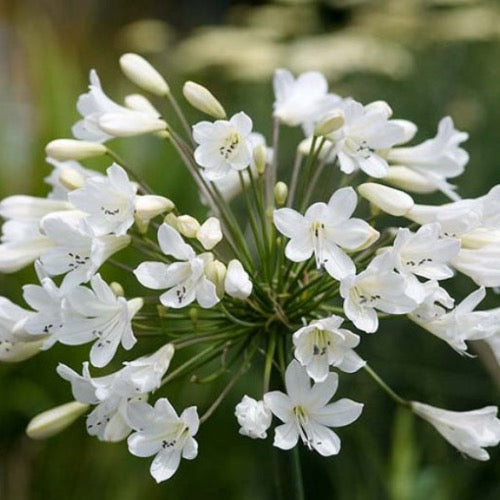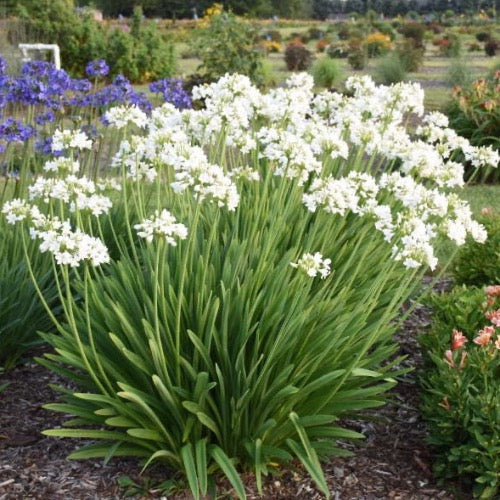
Plant It Tampa Bay
Agapanthus 'Elaine' (Lily of the Nile) White
Couldn't load pickup availability
Overview
Agapanthus 'Elaine' (Lily of the Nile)
An evergreen plant with eye-catching, purple flower clusters that rise above the foliage in summer. The grass-like foliage mounds are attractive even when not in bloom. Perfect choice for the cutting garden as the blooms survive up to 10-days as cut flowers. Use in groups to line a border or pathway, or as a garden accent. Plant directly into the ground in USDA zones 8-10, otherwise, either grow in a container and move to a sunny, frost free location to overwinter, or simply replace it the following spring with a whole new plant.
- Plant in groups to create a lush, tropical feel to the landscape
- Bees and butterflies are attracted to the bold flower clusters
- Thrives in full sun to part shade and grows in almost any well-drained soil
 |
Advantages:
|
 |
Grows Best:Landscape House Plant Container Plant |
 |
Ideal position:Performs best in Sun Light Any light is fine. Sun: full to part Sun, 6 plus hours direct sun daily |
|
|
Growth Outlook:Height : 24" Wide: 18" Growth Rate: Fast Plant Spacing: 12" - 18" |
 |
Pet Friendly - Yes
|
Description
Agapanthus 'Elaine' (Lily of the Nile)
Agapanthus, commonly known as Lily of the Nile or African Lily, is a stunning flowering plant that adds a touch of elegance to any garden or landscape. Native to South Africa, Agapanthus is cherished for its striking clusters of trumpet-shaped flowers and its lush, strap-like foliage.
The flowers of Agapanthus come in a range of colors, including shades of purple, and white. They bloom atop tall, sturdy stems that can reach heights of up to three feet, creating a dramatic display in the garden. The flowers attract pollinators like bees and butterflies, adding to the plant's allure.
Agapanthus is a hardy perennial that thrives in full sun to partial shade. It prefers well-draining soil and can tolerate a range of soil types, making it adaptable to various garden conditions. Once established, it is relatively drought-tolerant, making it a low-maintenance choice for gardeners.
The foliage of Agapanthus is evergreen in warmer climates, providing year-round interest. The long, arching leaves form attractive clumps that add structure and texture to the garden even when the plant is not in bloom.
Agapanthus is versatile and can be used in various garden settings. It works well as a border plant, in mass plantings, or as a focal point in containers. It also makes a beautiful cut flower, adding a touch of elegance to floral arrangements.
With its stunning flowers, attractive foliage, and easy-care nature, Agapanthus is a popular choice for gardeners looking to add beauty and sophistication to their outdoor spaces. Whether used in formal gardens or more relaxed landscapes, this plant never fails to make a statement.
Where To Plant
- Filler plant for a garden corner
- Along a deck or patio
- In a pool cage planter (in an area that won't get splashed)
- Between palm trunks
- Entryway accent
- Large, full plant for the corner of the house
- Under tall trees
- Container plant
Caring For
 |
 |
 |
 |
| Ideal position | Water | Temperatures | Food |
Caring for an Agapanthus plant involves several steps to ensure its healthy growth and beautiful blooms:
1. Watering: Agapanthus plants are relatively drought-tolerant once established, but they do prefer regular watering during the growing season. Water deeply and allow the soil to dry out slightly between waterings. Reduce watering in the winter when the plant is dormant.
2. Soil: Agapanthus prefers well-draining soil. It can tolerate a range of soil types, but it does best in a rich, loamy soil. If your soil is heavy clay or sandy, consider amending it with organic matter to improve its texture and fertility.
3. Light: Plant your Agapanthus in a location where it will receive full sun to partial shade. More sun will encourage more abundant flowering.
4. Fertilizing: Feed your Agapanthus in the spring with a balanced, slow-release fertilizer to promote healthy growth and flowering. Follow the manufacturer's instructions for application rates.
5. Pruning: Deadhead spent flowers to encourage more blooms. In late fall or early spring, cut back any dead or yellowing leaves to keep the plant looking tidy.
6. Overwintering: In colder climates, Agapanthus may need some protection from frost. Mulch around the base of the plant or bring potted Agapanthus indoors.
7. Pests and Diseases: Agapanthus is generally pest-free, but watch out for common garden pests like slugs and snails. If necessary, treat any infestations with appropriate insecticides or organic pest control methods.
By following these care guidelines, you can ensure that your Agapanthus plant remains healthy and produces its stunning blooms year after year. Regular attention to watering, light, and proper maintenance will help your plant thrive.
Plant spacing
Plant 3 or 4 feet apart. Come out from the house 3 feet.
If you're planting near a walk or drive, come in at least 3 feet (more if you can) to give the plant room to grow wide without getting in the way.
Allow enough room between Hope and the plants near it...the large leaves may overlap other, smaller plants once the philodendron has begun to mature.
This is a very good plant for large containers - great for balconies, patios, even indoors.
Share








